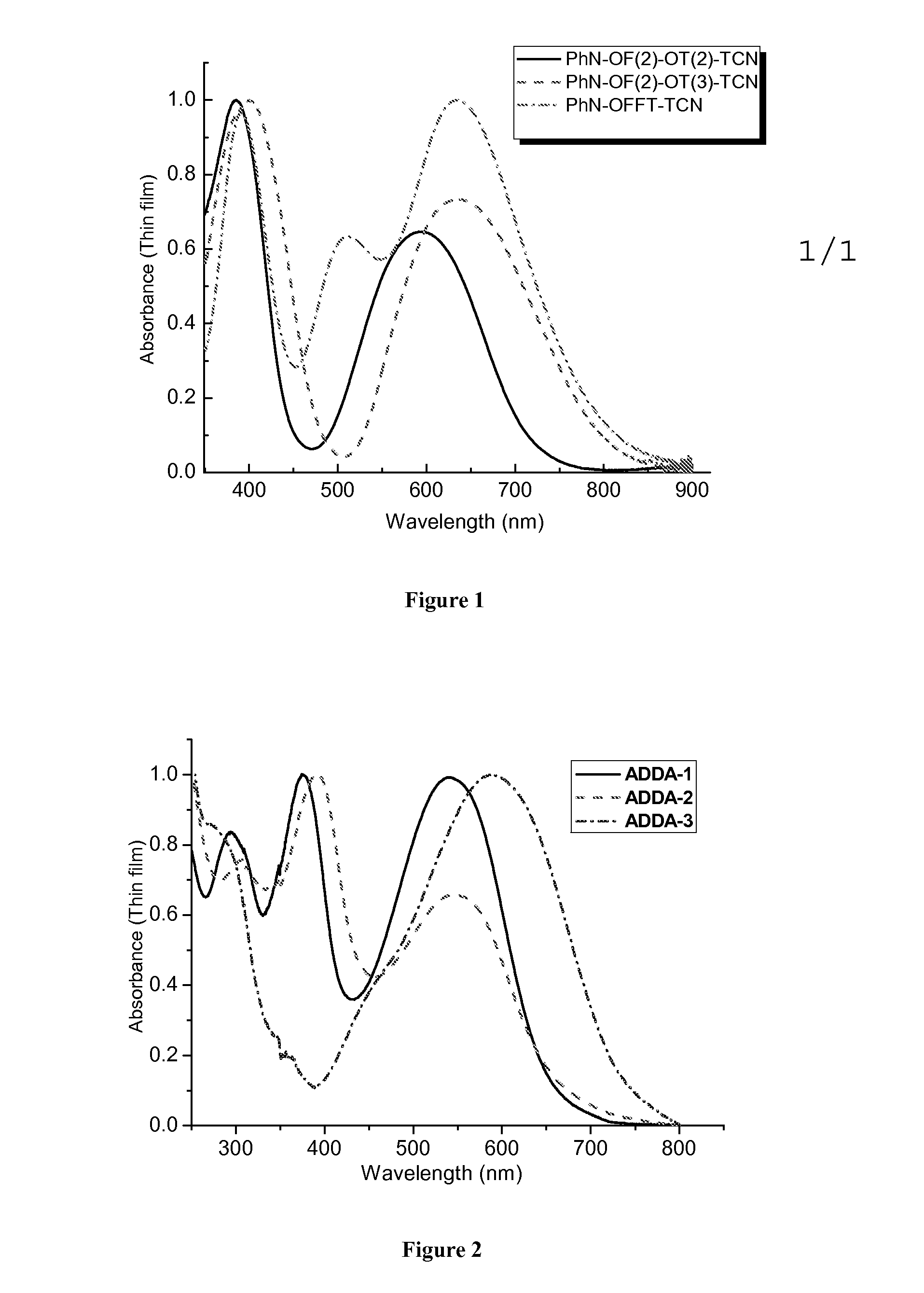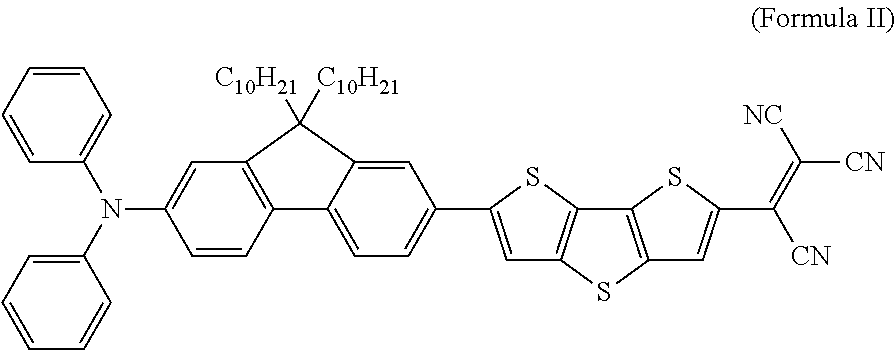Low bandgap dicyanovinyl and tricyanovinyl oligothiophenes for solar cell applications
a technology of dicyanovinyl and tricyanovinyl oligothiophene, which is applied in the direction of organic chemistry, solid-state devices, semiconductor devices, etc., can solve the problems of large amount of carbon dioxide generated by combustion of fossil fuels, high cost of harvesting, and undesirable air pollutants
- Summary
- Abstract
- Description
- Claims
- Application Information
AI Technical Summary
Benefits of technology
Problems solved by technology
Method used
Image
Examples
example 1
[0022]
[0023]Example 1 embodies an oligothiophene-containing compound (Compound 1, PhN—OF(2)OT(2)-TCN and PhN—OF(2)OT(3)-TCN) comprising a diphenylamino-bisfluorenyl group as the electron-donating group and a tricyanovinyl group as the electron-withdrawing group, wherein n of the thiophene group is selected from a range of 2 to 3
[0024]The synthesis of Compound 1 is outlined in Scheme 1. Under a basic condition, 2,7-dibromofluorene was converted to a double alkylation product 9,9-bis-(n-butyl)-2,7-dibromofluorene 1, in a high yield (92%). After Buchwald-Hartwig amination of 1, 2 was converted to boronic acid 3 by means of lithiation followed by reacting with trimethylborate and then hydrolysis. Suzuki cross-coupling reaction of boronic acid 3 and 9,9-bis-(n-butyl)-2,7-dibromofluorene 1 afforded PhN—OF(2)-Br 4 in a good yield, which was then converted to boronic acid, R2—B(OH)2 using a similar method. Palladium catalyzed Suzuki cross-coupling reaction of R2—B(OH)2 and 5-iodo-2,2′-bithi...
example 2
[0025]
[0026]Example 2 embodies an oligothiophene-containing compound (Compound 2, PhN—OFFT-TCN) comprising a diphenylaminofluorenyl group as the electron-donating group and a tricyanovinyl group as the electron-withdrawing group.
[0027]Compound 2 was synthesized as shown in Scheme 2. Under acid condition, dithieno[3,2-b:2′,3′-d]thiophene (Organic Syntheses, Vol. 83, p. 209 (2006)) was reacted with NBS affording 2-bromodithieno[3,2-b:2′,3′-d]thiophene 7, which underwent Suzuki cross-coupling reaction with boronic acid R1—B(OH)2 (J. Mater. Chem., 2010, 20, 2182-2189) to afford intermediate 8 in 71% yields. Finally 8 was converted to PhN—OFFT-TCN by reacting with n-BuLi and tetracyanoethylene at low temperature in 85% yield.
example 3
[0028]
[0029]Example 3 embodies oligothiophene-containing compounds (Compound 3-1, ADDA-1 and Compound 3-2, ADDA-2), each comprising two diphenylaminofluorenyl groups as the electron-donating groups and two dicyanovinyl groups as the electron-withdrawing groups, wherein n of each of the fluorenyl group is independently selected from a range of 1 to 2.
[0030]The structure design of Compound 3-1 and Compound 3-2 is based on the twisted bithiophene skeleton due to the steric effects. (J. Adv. Funct. Mater. 2007, 17, 1163). The incorporation of bulky groups at the 3- and 3′-positions of bithiophene could produce a dihedral angle between the thiophene rings, thus generating a nonplanar core for the construction of these compounds.
[0031]Scheme 3 outlines the synthetic route for ADDA-1 (n=1) and ADDA-2 (n=2). Palladium-catalysed Kumada coupling reaction of freshly prepared Grignard reagent of 2-bromothiophene in dry tetrahydrofuran (THF) with 2-bromothiophene afforded bithiophene 9 in high y...
PUM
 Login to View More
Login to View More Abstract
Description
Claims
Application Information
 Login to View More
Login to View More - R&D
- Intellectual Property
- Life Sciences
- Materials
- Tech Scout
- Unparalleled Data Quality
- Higher Quality Content
- 60% Fewer Hallucinations
Browse by: Latest US Patents, China's latest patents, Technical Efficacy Thesaurus, Application Domain, Technology Topic, Popular Technical Reports.
© 2025 PatSnap. All rights reserved.Legal|Privacy policy|Modern Slavery Act Transparency Statement|Sitemap|About US| Contact US: help@patsnap.com



